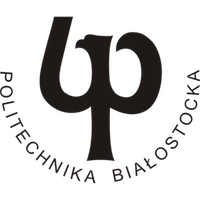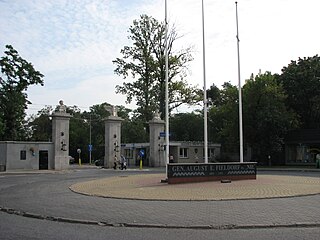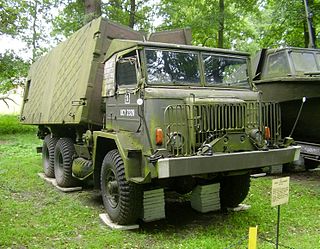Wojskowa Akademia Techniczna im. Jarosława Dąbrowskiego | |
 | |
| Motto | Omnia pro patria |
|---|---|
Motto in English | Everything for the country |
| Established | 1951 |
| Rector | Brig. Gen. prof. dr hab. inż. Przemysław Wachulak |
| Students | 8,014 [1] (12.2023) |
| Address | ul. gen. Sylwestra Kaliskiego 2, 00-908 Warszawa 49 , , |
| Affiliations | EUA, Erasmus |
| Website | www |
 | |
Military University of Technology (Wojskowa Akademia Techniczna im. Jarosława Dąbrowskiego, Wojskowa Akademia Techniczna or WAT) [2] is the civil-military technical academic institution in Poland, located at Bemowo, Warsaw. It was established in 1951. The university's rector-commander is Brig. Gen. Przemysław Wachulak. The university is supervised by the Minister of National Defence of Poland and conducts scientific research for the needs of Polish Armed Forces. Currently the university educates almost 10,000 students. The staff consists of about 1,000 employees, including 220 professors. [3]
Contents
University leads both military and civilian studies. Military graduates receive not only professional title of magister inżynier, but are also promoted to military rank of podporucznik (second lieutenant). [3] Formally being professional soldiers, military students attend school on the principles of ordinary military service. They are quartered in military dormitories and attend a variety of different military trainings and lectures. After graduating, they are formally obliged to serve in Polish Armed Forces under threat of reimbursement of education costs. Only Polish citizens are eligible for military studies. [4]
Contrary to military students, civilian ones can study normally, without any commitments to the Ministry of National Defence. [3] Civilian studies allow to obtain professional titles such as: inżynier or licencjat (first cycle studies), magister inżynier or magister (second cycle studies) and a scientific degree of doktor. [3] Due to changes in Polish law, since October 2019, separate Doctoral School operates in the structure of WAT. [3] Full-time studies are free, extramural studies are payable. [4]
Obviously, scientific research conducted in WAT focus on issues connected with military and national defense. WAT was the place where in 1963 first Polish laser was created. In 1964 analog computer ELWAT (later produced by Elwro in Wrocław) was also created in WAT. One of the biggest contemporary projects which was developed at the university was so-called Modular Firearm System, 5.56 mm MSBS rifle, currently manufactured and further developed by FB "Łucznik" Radom. [5] [6] The rifle is to become the next main service rifle of the Polish Armed Forces.
WAT continues to develop its research and educational infrastructure, expanding its specialist and interdisciplinary laboratories, Academic Entrepreneurship Incubator, Technology Transfer Centre, Security Engineering Centre, National Space and Satellite Engineering Centre, Advanced Energy Technologies Centre, Reconnaissance and Electronic Warfare Support Centre, Mobile Robots Centre, and the Quality Certification Centre.
The courses offered by the university are accredited by the Polish Accreditation Committee (PKA) and the Accreditation Commission of Universities of Technology (KAUT). Among the courses offered there are those that have been awarded Educational Excellence Certificates:
– in the Excellent Course – Excellence in Education category: cryptology and cybersecurity;
– in the Always for the Student category – Excellencein Student Development Support: information technology. [7]













